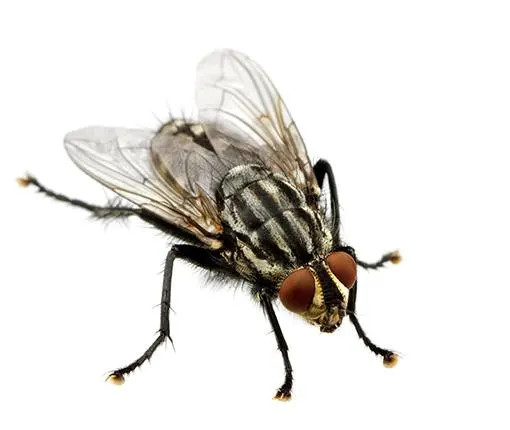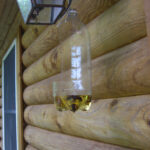Flies, persistent and irritating, have plagued human environments for millennia. More than just a nuisance, they are vectors of disease, capable of transmitting pathogens that impact human health. Common houseflies, often categorized as filth flies, thrive in unsanitary conditions like decaying food, animal waste, and garbage, highlighting their potential to spread contamination.
The rapid life cycle of a fly, from egg to adult in as little as ten days, means that a minor fly issue can quickly escalate into a significant infestation. Long-term fly eradication hinges on diligent sanitation and exclusion practices.
This article will guide you through identifying different fly species and implementing effective strategies to eradicate fly infestations within your home.
Effective Fly Control Management Strategies
A robust fly control strategy begins with meticulous sanitation and exclusion techniques. Following these foundational steps, a range of insecticides can be employed, including residual treatments, aerosols, fogging solutions, and bait systems, to manage and eradicate fly populations effectively.
Diverse Fly Control Options
Various product options are available to tackle fly infestations. These include liquid concentrate insecticides for broader application, insecticide dusts for targeted areas, fast-acting pyrethrin aerosols for immediate knockdown, specialized fly light traps to attract and capture flies, fogging agents for space treatments, enticing fly baits to lure and eliminate flies, and outdoor fly traps designed for perimeter defense.
Drain flies can pose a particular challenge in kitchens, both at home and in commercial settings like restaurants. Invade Bio Treatment Gel offers an effective solution for drain management. This natural, microbe-based product works to break down organic buildup within drains, eliminating breeding grounds for these flies.
Fly lights, utilizing specific UV spectrums, are highly effective in attracting and trapping flies. Their effectiveness makes fly lights a popular choice for commercial environments. Fly glue traps are also readily available for a less technical trapping approach.
For detailed information tailored to specific fly types, explore our resources on Filth Flies, Small Flies, and Nuisance/Biting Flies through the provided links.
 A close-up of various fly control products, highlighting the tools available for fly eradication.
A close-up of various fly control products, highlighting the tools available for fly eradication.
Natural Remedies for Fly Eradication
For managing fly infestations in outdoor settings, fly traps can be remarkably efficient. Many fly traps utilize attractants derived from putrescent—or rotten—eggs, emitting odors that are offensive to humans but highly appealing to flies. Indoors, essential oils and other natural fly repellents can be effective, particularly in smaller spaces.
Fly traps can capture substantial numbers of flies and require replacement once full. In cases of severe infestations, consider strategically placing multiple fly traps around your property perimeter. For optimal effectiveness, position traps away from your house to avoid inadvertently drawing flies closer to your living areas.
Here are 5 highly effective natural remedies to help you eradicate flies:
1. The Rotten Food Fly Trap: A Decoy and Destroyer
Instead of discarding spoiled food, repurpose it into a fly trap. Place the rotten food in a container and securely cover it with plastic wrap. Create several small holes in the plastic, just large enough for flies to enter. Position the container in areas with high fly activity. Flies will be drawn to the bait, enter the trap, and become confined. Once they perish, dispose of the entire trap and repeat as needed until the fly problem is resolved.
2. Apple Cider Vinegar and Dish Soap Trap: Sweet Scent, Sticky End
A widely recognized DIY solution for fly eradication is the Vinegar Trap. In a disposable container, mix water, a spoonful of sugar, a squirt of dish soap, and a few tablespoons of apple cider vinegar.
Gently stir the mixture to dissolve the sugar. Place this concoction in areas heavily infested with flies. The sweet scent of vinegar will attract flies, and the dish soap reduces surface tension, causing them to drown upon contact. Replenish the trap as needed until flies are no longer present.
3. Red Wine Fly Trap: A Boozy Bye-Bye for Flies
Don’t discard leftover red wine; it can be an effective tool in your fly eradication arsenal! Pour the wine into a container, add a bit of dish soap, and cover the opening with plastic wrap.
Poke small holes in the plastic to allow flies access. The aroma of red wine is enticing to flies, drawing them into the trap in search of a drink. The dish soap will ensure they cannot escape and will ultimately drown.
4. Essential Oils: Nature’s Fly Repellent
If you prefer a repellent approach, essential oils offer a natural way to deter flies from problem areas. Strong, pungent scents like clove, pine, lemongrass, eucalyptus, lavender, mint, rosemary, peppermint, tea tree, and citronella are notably repulsive to flies, acting as effective natural repellents.
Lemon eucalyptus essential oil, in particular, has shown significant effectiveness for many in repelling flies due to its potent scent. To protect the perimeter of your property, apply a few drops of your chosen essential oils to strips of cloth to create DIY fly paper. Alternatively, use a spray bottle to apply diluted essential oil mixtures to outdoor spaces like decks and patios.
5. Fans and Candles: Airflow and Scent Deterrents
Wondering How To Eradicate Flies in outdoor spaces? A simple fan can be surprisingly effective in smaller outdoor areas. Flies prefer calm air for flying; the constant air movement from a fan disorients them and makes it difficult to land and linger. Citronella candles also serve as effective natural fly deterrents. While primarily known for mosquito repellent properties, they are also quite effective at repelling flies, especially in confined outdoor settings.
Identifying Fly Types for Targeted Eradication
Filth Flies: The Disease Vectors
Filth flies, including common house flies, are not only a nuisance but also pose potential health risks to humans and animals. Their habits directly contribute to the spread of bacteria and other disease-causing organisms. Filth flies are notorious for feeding and laying eggs in unsanitary materials such as garbage, manure, and decaying carcasses.
When these flies land on human food or food preparation surfaces, they can easily transfer contaminants. House flies, for instance, are known to transmit diseases like food poisoning and dysentery.
TYPES OF FILTH FLIES
Small Flies: Minor in Size, Major in Nuisance
Many small fly species (around 1/4 inch in size) are commonly found in food preparation areas and can be carriers of disease-causing organisms.
The following six fly species are among the most frequently encountered small flies.
TYPES OF SMALL FLIES
Nuisance and Biting Flies: Annoyance and Pain
Many common flies encountered around homes are both a nuisance and capable of biting. Like many fly species, these flies breed in decaying organic matter and animal waste.
They can transmit bacteria and viruses to humans. Flies such as stable flies and horse flies, often referred to as “biting flies,” feed on mammalian blood, inflicting painful bites.
TYPES OF NUISANCE AND BITING FLIES
Accurate identification of the fly species is a critical step in implementing the most effective eradication strategy.
Preventing Fly Entry: Proactive Measures for a Fly-Free Home
As with most pest management, the most effective approach to preventing flies is maintaining cleanliness in and around your home. Focus particularly on keeping kitchen areas free of exposed food by storing all food items in airtight containers that flies cannot penetrate.
Sanitation: The Cornerstone of Fly Prevention
Sanitation is paramount in any effective fly management program. The primary goal of sanitation is to eliminate or prevent the development of any environments conducive to fly larvae. Equally important is removing attractants for adult flies, such as garbage and animal waste. Moisture is a key factor in fly breeding materials; therefore, ensuring good drainage wherever possible is essential. Without a readily available water source, flies will either perish or relocate.
Decomposing Organic Waste: A Powerful Fly Magnet
Nothing attracts flies more intensely than decomposing organic waste. They are drawn to any plant or animal-based material, including compost, rotting vegetables, or animal feces, and will lay thousands of eggs on these sources. The hatched eggs develop into maggots, which quickly mature into adult flies. Eliminating these sources is vital for maintaining a fly-free property.
- Regularly clean garbage cans with a bleach solution. Compost bins should be kept covered and ideally located away from living areas.
- Invade Bio Foam, an all-natural probiotic product, can be used to treat organic debris buildup in dumpsters. Soldier fly larvae are often found around dumpsters and garbage cans. Ensure garbage cans have tight-fitting lids. Position garbage cans as far from building entrances as possible to minimize flies moving indoors.
- Repair any damage to window screens and doors. Use fine mesh screens on all building openings. For doorways that must remain open for business or access, install air curtains. Air curtains operating at a velocity of 1,600 feet per minute or higher can effectively prevent fly entry.
- Promptly remove pet waste from yards. Flies are attracted to and breed in pet waste due to its moisture content.
- Wipe down all surfaces that come into contact with food regularly.
- Decomposing bodies of rodents and birds can significantly exacerbate fly problems. Remove any dead animals promptly, as flies will lay eggs on them, leading to maggot infestations and subsequent adult flies.
- Avoid overwatering indoor potted plants. Excessively moist soil provides an ideal breeding ground for gnats. Ensure plant pots are well-drained.
- Maintaining clean outdoor areas is crucial for fly prevention. Clear away soiled flower bedding, decaying plants, straw, and animal matter.
Explore Our Fly Control Product Range
Ready to take decisive action against bothersome flies? Browse our carefully selected range of fly control products, designed for both indoor and outdoor application. Whether you are dealing with house flies, fruit flies, or any other type, our product selection offers solutions from eco-friendly options to advanced traps and repellents. Each product is chosen for its effectiveness and safety, ensuring you can address your fly problem without compromise. Don’t let flies dominate your space any longer. Visit DIY Pest Control and begin enjoying a fly-free environment today.
Shop Fly Control Products
Frequently Asked Questions About Fly Control
What Attracts Flies to My Home or Garden?
Flies are primarily attracted to decaying organic matter such as food waste, pet excrement, overripe fruits, and standing water. Reducing these attractants by maintaining cleanliness, promptly disposing of garbage, and eliminating standing water sources can significantly help in preventing fly infestations.
Are There Natural Remedies to Eradicate Flies?
Yes, several natural remedies can effectively help eradicate flies. These include using essential oil sprays with scents like lavender or eucalyptus, setting up traps using vinegar or wine, and cultivating fly-repelling plants such as basil and lavender around your home.
How Can I Prevent Flies from Entering My House?
Preventative measures to keep flies out of your house include sealing cracks and openings in walls and foundations, installing fine mesh screens on windows and doors, managing waste properly by using sealed bins, and keeping doors closed as much as possible to block potential entry points.
How Do I Safely Eradicate Flies in Kitchens and Food Areas?
To safely eradicate flies in kitchen or food preparation areas, opt for non-toxic methods such as sticky traps or UV light traps. Maintain rigorous cleanliness, store food in airtight containers to eliminate attractants, and regularly dispose of garbage, ensuring no food waste is readily available.
Can Flies Transmit Diseases?
Yes, flies are capable of transmitting various diseases, including food poisoning and dysentery, by contaminating food and surfaces. Protect your household’s health by diligently maintaining cleanliness, implementing consistent fly control measures, and ensuring food is always covered and properly stored.
